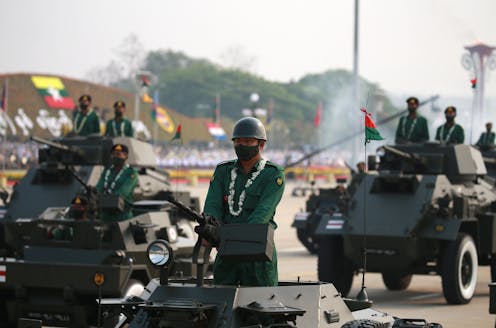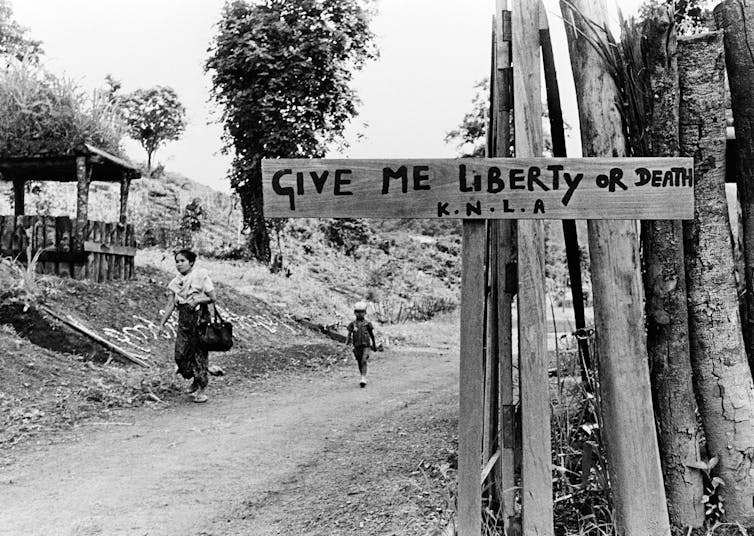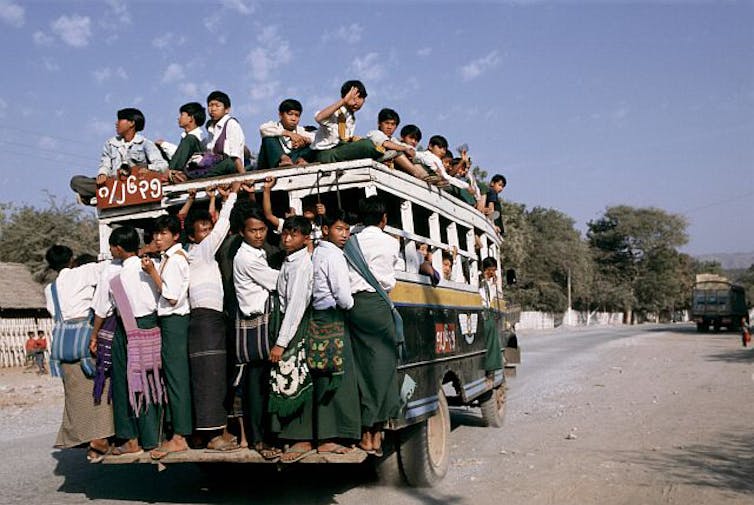Myanmar's brutal military was once a force for freedom – but it's been waging civil war for decades
What began in the 1940s as a revolutionary army created to liberate Myanmar from British colonial rule soon turned repressive. The country has been a military dictatorship on and off since 1962.

With great fanfare – but few guests – Myanmar’s armed forces recently celebrated their 76th anniversary in the nation’s capital of Naypyitaw.
Only Russia, China, Thailand and a handful of other Asian countries sent representatives to attend the March 27, 2021, parade showing off Myanmar’s modern war machines – mostly imported from Russia and China over the past decade, to the tune of US$2.4 billion.
The Myanmar military has been terrorizing civilians since a coup two months earlier. On the day of the parade, soldiers killed over 90 people for protesting military rule, including a 5-year-old boy and three teenagers. An estimated 564 people have been killed in Myanmar since the Feb. 1 coup.
One of Asia’s poorest countries, Myanmar spends twice as much on defense as it does on education and health combined. With half a million soldiers, at least on paper, Myanmar has the world’s 38th strongest military, according to Global Fire Power, which ranks 140 nations on their capability to wage war.
Myanmar’s military wasn’t always a repressive force. It began as an adored liberating force founded to end colonial rule.
History of the Burma army
Burma’s first national army came out of World War II and the quest for independence.
Led by a group called the “30 comrades” who received military training from the Japanese,“ the Burma Independence Army allied itself with Japan to fight the British. Everyday people sold their gold to support this revolutionary force.
The Burma Independence Army forced the British out in 1941. The Japanese then occupied Burma, fighting Britain, the U.S. and other Allied forces from this strategic location in Southeast Asia.
Soon, though, Burma’s army wanted Japan out of Burma, too. So did many Burmese people. Thousands of members of ethnic and religious minorities from rural border areas joined the army.
Historically, these minority groups had kept their distance from the country’s Buddhist majority, called Bamar, and from each other. The British maintained and strengthened these ethnic divisions as a tactic to maintain their colonial rule.
But during the 1940s resistance movement against the Japanese, everyone was united behind Burma’s army, my research finds – including women.
In 2007 I interviewed the first five women soldiers who joined Burma’s struggle for independence.
"When the resistance movement began, we were ready to give everything, including our lives,” Daw Khin Kyi Kyi, then in her 80s, told me.
The women attended military training, traveled to villages near army camps to explain why the army was now fighting against the Japanese, and convinced locals to offer food and shelter to the soldiers. The women also enlisted locals to spy on Japanese troops.
Civil war begins
The Japanese surrendered to the Allied forces in 1945 and withdrew from all occupied territories, including Burma.
That put Burma back in British hands, with promises of full sovereignty.
Before the British would grant Burma independence, however, they demanded that the country’s Bamar leadership prove that its many minority groups also wanted independence as one nation. Burma’s revolutionary army leader Aung San convened a summit in the town of Panglong with the leaders of various ethnic groups to negotiate the foundations of a unified, independent Burma.
However, the Karen, a mostly Christian population from the country’s southeast, had previously been promised British help in establishing their own free state. Karen leaders refused to join the 1947 Panlong Agreement.
Burma became independent in 1948. The next year, elite Karen troops staged an armed revolt against the new national government.

Ever since, Myanmar’s military, called Tatmadaw, has essentially existed solely to fight against Myanmar’s minorities.
Myanmar’s war economy
For about a decade after independence, Burma had a democratic government. But the army was more powerful. Between 1962 and 2010, Burma was a military dictatorship. Military rule endured through occasional uprisings, show elections and several coups in which one set of generals overthrew another.
Civil war is costly, so Myanmar developed a war economy. At first, it funded its battles with rice exports and loans from the U.S. and Soviet Union. Over time, Burma’s military entrenched itself in the global economic system.
In 1962, the military junta regime established Burma Trade Limited in central London as its “legitimate” international brokerage. The military also mined and sold jade, mostly in areas that were home to repressed ethnic minorities and profited from a lively opium trade in Burma.
This military-controlled economy enriched Burma’s generals, but the money did not translate into national economic growth. In 1987, the United Nations rated Burma among the world’s “least developed countries.”

Burma’s name was changed to Myanmar in 1989.
Sanctions and boycotts
Today, Myanmar’s economy is almost entirely controlled by the military, from telecommunications to drugs. The military’s sprawling business networks – which some rights groups call “cartels” – have protected the generals from attempts to democratize.
In 2008, for example, the Myanmar military assented to a new Constitution officially giving 75% of seats in Parliament to civilian politicians and reserving 25% for army representatives.
Unofficially, though, the military largely continued to run the nation. That included unrelenting repression of minority groups, including the Karen – who have maintained their insurgency for seven decades – and the Rohingya Muslims.
[Deep knowledge, daily. Sign up for The Conversation’s newsletter.]
Elections in 2015 were supposed to mark a turning point in this quasi-democratic system. Aung San Suu Kyi, daughter of the revolutionary Aung San and leader of a prior democratic uprising, and her National League for Democracy won in a landslide.
Suu Kyi faced criticism for failing to stand up to the military, particular in its assaults on the Rohingya. Even so, she was deposed in the February 2021 coup and is now detained in an unknown location. Some dissidents are fleeing into to Karen territory and other rebel-held ethnic areas to escape the military.
As the death toll in Myanmar mounts, international pressure is growing for countries to impose harsher sanctions on the junta and for companies to cease trade. Japan’s Kirin beer and a German company that supplies the Myanmar mint are among those that have cut ties with Myanmar.
Meanwhile, civil disobedience inside the country continues. Choking off the military’s funding could give the protesters and deposed civilian government a fighting chance.
Tharaphi Than does not work for, consult, own shares in or receive funding from any company or organisation that would benefit from this article, and has disclosed no relevant affiliations beyond their academic appointment.
Read These Next
School shootings dropped in 2025 - but schools are still focusing too much on safety technology inst
Prevention methods like lockdown drills do not account for many scenarios, including the likely case…
From record warming to rusting rivers, 2025 Arctic Report Card shows a region transforming faster th
The 20th anniversary of the annual report tracks how sea ice, snow cover and many other vital signs…
2 superpowers, 1 playbook: Why Chinese and US bureaucrats think and act alike
The men and women tasked with implementing policy are governed by the same incentives and constraints…





